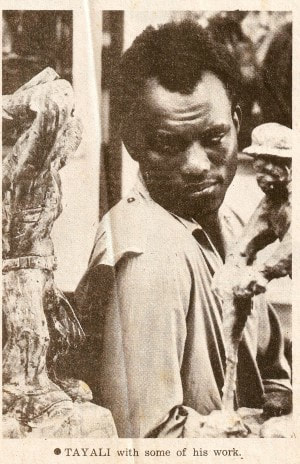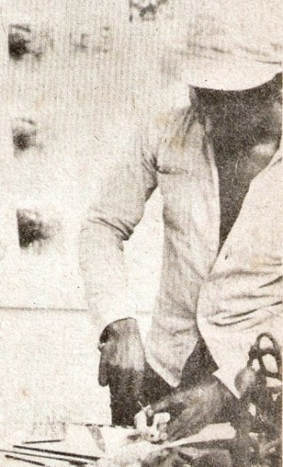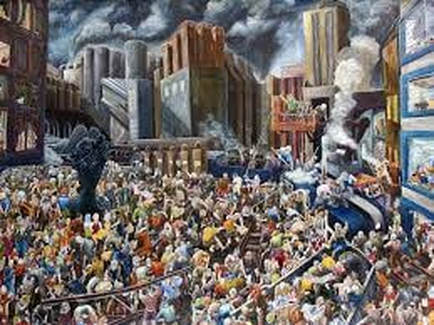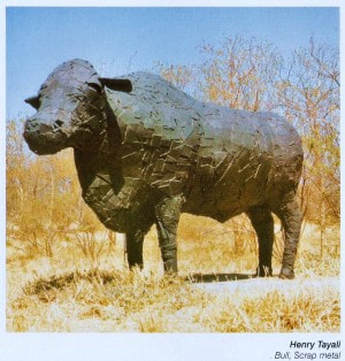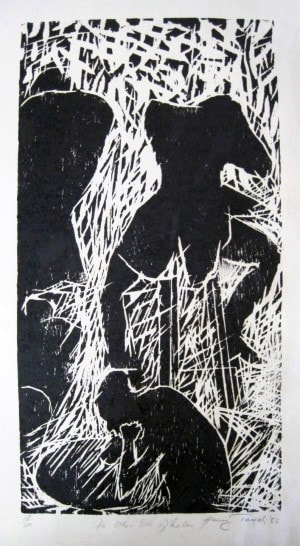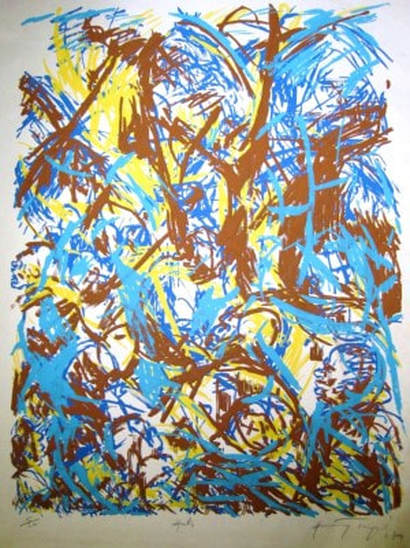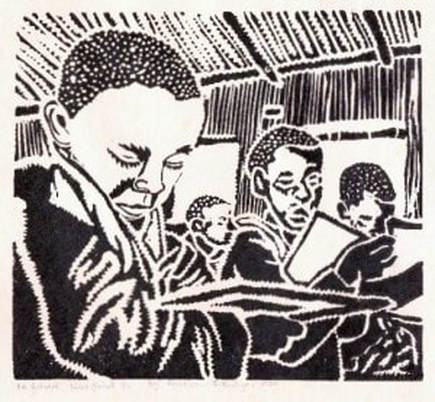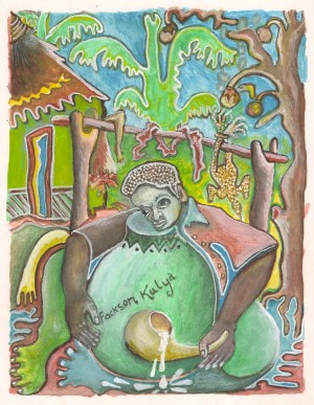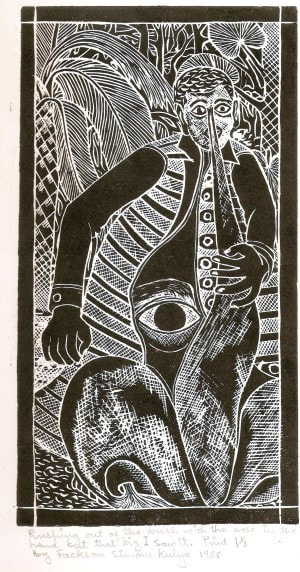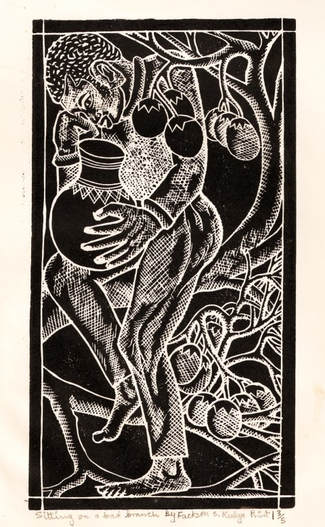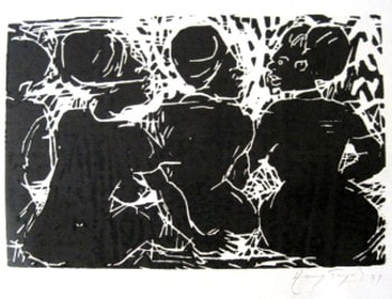HENRY TAYALI AND FACKSON KULYA:
Academic and Folk Art in Zambia of the Seventies and Eighties
Internet publication by Bert Witkamp
First published: April 2013 in the Art in Zambia Blog
Current version published 14 November 2018
Internet publication by Bert Witkamp
First published: April 2013 in the Art in Zambia Blog
Current version published 14 November 2018
Henry Nkole Tayali and Fackson Kulya were two artists socially at opposing sides of the Zambian art scene of the seventies and eighties. Tayali's life and work is closely associated with the University of Zambia in a position that brought him prestige and security. He became Zambia's best known artist nationally and internationally. Today, over 40 years after his death, Tayali's’s artistic legacy is still alive and kept alive. Fackson Kulya for some time lived in the servants quarters of one of the staff houses of the same university, supported by a sympathetic lecturer. He never rose to international fame and all his life had to struggle to make ends meet. The precise date and circumstances of his death are obscure. In this paper an effort to juxtapose and relate Zambia’s best known artist to an artist seemingly bound for oblivion – or is he not?!
At first sight a comparison between Henry Tayali and Fackson Kulya seems unjustifiable as there does not seem to be an appropriate plane for comparison. Yes, there are common elements in their lives: both were Zambian artists, contemporaries (Tayali was a bit older but of the same generation); and both were sculptors, painters and graphic artists. The differences, however, are much more striking. They lived in very different social worlds with few bridges in between.
Tayali (1943-1987) was a well educated, academic artist who lead his professional life in association with the University of Zambia (UNZA) located at Lusaka as lecturer and resident artist. He was accommodated by UNZA at Handsworth Court; a pleasant housing complex for university staff adjacent to the university grounds. He, though born Zambian, had spent many years in what at that time was Southern Rhodesia where he attended a good secondary school in Bulawayo. It was, for an African, quite a feat in the colonial days to access and complete secondary school. This accomplishment alone destined him to become a member of the first generation post independence African élite. The same feat also is a testimony of the foresight, perseverance and ambition of his father who lived to give Henry and his siblings an education that opened up the doors to social and professional achievement. Tayali commenced his academic education by studying for four years at the then prestigious Makerere University in Uganda where he obtained a B.A. in Fine Art in 1971. Two years later he was accepted at the Düsseldorf Academy of Art in what then was West Germany. He was the first African student to receive a German study grant at that institution. During three years he studied graphic arts and sculpture. Tayali thus had a good share of multi-cultural exposure, an excellent education and had been exposed to the international art world.
When he settled in Zambia in 1975 he was from the start accepted as a major, if not the main, indigenous Zambian modern artist. He was welcomed socially by the artistic élite of the day in a scene dominated by people of European background and the new African elite, an élite that in many ways had adopted a western lifestyle including appreciation of the fine arts. These artists and art lovers, African or European, were happy to accept Henry in their midst in a leading role as he was socially and culturally one of them and a genuine, productive artist and native to Zambia. Henry not only belonged to the first generation indigenous post independence élite, he belonged to a considerably smaller group within this class; that of professional people who not only were well educated and had senior positions in society, but also were competent and dedicated to their profession. He from time to time had commissions, sometimes major ones; and his paintings and graphics sold nationally and internationally.
Fackson Kulya (born around 1945, died around 1990) also lived for some time at Handsworth Court; not in a residential house but in a servant’s quarter - made available to him by a sympathetic and sympathizing expatriate British lecturer. Fackson was a self-taught artist, an autodidact, born in Luanshya rural, a Lamba by tribe. He must have had some formal education as he could speak, read and write in English; but definitely not much, if anything, beyond primary school. Fackson has never been outside of Zambia, and most of Zambia remained unknown to him. He did not like town life and in the eighties returned to his village near Luanshya. He lived there till he died. He was a villager at heart. In the village you are poor with your fellow villagers; all are the same. In town you are poor because there are rich people; and you depend on these rich people to buy your art.
Fackson and Henry commenced their professional career almost at the same time, but by then, in 1974-75, Tayali had seven years of academic training behind him while Fackson was learning “on-the-go.” What UNZA was to Tayali – an enabling, inspiring environment – was the Lusaka Artist group (LAG, later the Zambian Artists Association) to Fackson. In the workshop at the Evelyn Hone College – made available by the College on request of the Art Centre Foundation (AFC, a government sponsored body that was to promote the arts) - he met and worked with friends. He now had company in an environment created for art. Here, from 1976 to 1980, he did quite a bit of his learning: how to make lino cuts, use a printing press, make oil paint, prepare for exhibitions, become part of a social network and learned to deal with members of the uppa mwamba; the elite, the people who supported him and at times bought his work. The small group of Zambian artists at the AFC/LAG studio were all in the same position: no or little formal education in art, newcomers to the scene, trying to make a living out of art in an environment that had little facilities or support for artists, and belonging to the lower strata of society, that of the so-called common folk; people with little money mostly living in the compounds (townships) spread out over the periphery of Lusaka and lacking the social skills or even the confidence to adequately deal with the local élite; the educated ones living in the residential areas. At the workshop he must have met Tayali a few times, but there was no communication. Tayali, in his own and in Fackson’s perception as well, belonged to the uppa mwamba, the people on top; with the others including Fackson below; stereotypically poor, dirty, uneducated and preferably voiceless. Kulya never had the security of a stable income and struggled for money all his life. Neither did he have the privilege of holding respected positions in society. Once in a while he was commissioned for sculptures, but he mostly depended on ad hoc sales by personal contacts, hawking, exhibitions usually organised by the Lusaka Artist group (later the Zambia Artists Association), occasional sales at the studio at “The College” and during the eighties and nineties by Mpapa Art Gallery - at the time Zambia’s only permanent art gallery.
Tayali and Kulya both were hard working, dedicated artists, and indeed, art is the plane that unites these two very different human beings. So let’s have a look at their art.
Tayali, over time, developed styles ranging from realistic, to free figurative rendering to non-representational. His first work, when he started art as a talented schoolboy in the sixties, was figurative and fairly realistic; with an expressionistic touch. His best known work of that early period is the large painting Destiny, now in the collection of the Lechwe Trust at Lusaka.
Tayali (1943-1987) was a well educated, academic artist who lead his professional life in association with the University of Zambia (UNZA) located at Lusaka as lecturer and resident artist. He was accommodated by UNZA at Handsworth Court; a pleasant housing complex for university staff adjacent to the university grounds. He, though born Zambian, had spent many years in what at that time was Southern Rhodesia where he attended a good secondary school in Bulawayo. It was, for an African, quite a feat in the colonial days to access and complete secondary school. This accomplishment alone destined him to become a member of the first generation post independence African élite. The same feat also is a testimony of the foresight, perseverance and ambition of his father who lived to give Henry and his siblings an education that opened up the doors to social and professional achievement. Tayali commenced his academic education by studying for four years at the then prestigious Makerere University in Uganda where he obtained a B.A. in Fine Art in 1971. Two years later he was accepted at the Düsseldorf Academy of Art in what then was West Germany. He was the first African student to receive a German study grant at that institution. During three years he studied graphic arts and sculpture. Tayali thus had a good share of multi-cultural exposure, an excellent education and had been exposed to the international art world.
When he settled in Zambia in 1975 he was from the start accepted as a major, if not the main, indigenous Zambian modern artist. He was welcomed socially by the artistic élite of the day in a scene dominated by people of European background and the new African elite, an élite that in many ways had adopted a western lifestyle including appreciation of the fine arts. These artists and art lovers, African or European, were happy to accept Henry in their midst in a leading role as he was socially and culturally one of them and a genuine, productive artist and native to Zambia. Henry not only belonged to the first generation indigenous post independence élite, he belonged to a considerably smaller group within this class; that of professional people who not only were well educated and had senior positions in society, but also were competent and dedicated to their profession. He from time to time had commissions, sometimes major ones; and his paintings and graphics sold nationally and internationally.
Fackson Kulya (born around 1945, died around 1990) also lived for some time at Handsworth Court; not in a residential house but in a servant’s quarter - made available to him by a sympathetic and sympathizing expatriate British lecturer. Fackson was a self-taught artist, an autodidact, born in Luanshya rural, a Lamba by tribe. He must have had some formal education as he could speak, read and write in English; but definitely not much, if anything, beyond primary school. Fackson has never been outside of Zambia, and most of Zambia remained unknown to him. He did not like town life and in the eighties returned to his village near Luanshya. He lived there till he died. He was a villager at heart. In the village you are poor with your fellow villagers; all are the same. In town you are poor because there are rich people; and you depend on these rich people to buy your art.
Fackson and Henry commenced their professional career almost at the same time, but by then, in 1974-75, Tayali had seven years of academic training behind him while Fackson was learning “on-the-go.” What UNZA was to Tayali – an enabling, inspiring environment – was the Lusaka Artist group (LAG, later the Zambian Artists Association) to Fackson. In the workshop at the Evelyn Hone College – made available by the College on request of the Art Centre Foundation (AFC, a government sponsored body that was to promote the arts) - he met and worked with friends. He now had company in an environment created for art. Here, from 1976 to 1980, he did quite a bit of his learning: how to make lino cuts, use a printing press, make oil paint, prepare for exhibitions, become part of a social network and learned to deal with members of the uppa mwamba; the elite, the people who supported him and at times bought his work. The small group of Zambian artists at the AFC/LAG studio were all in the same position: no or little formal education in art, newcomers to the scene, trying to make a living out of art in an environment that had little facilities or support for artists, and belonging to the lower strata of society, that of the so-called common folk; people with little money mostly living in the compounds (townships) spread out over the periphery of Lusaka and lacking the social skills or even the confidence to adequately deal with the local élite; the educated ones living in the residential areas. At the workshop he must have met Tayali a few times, but there was no communication. Tayali, in his own and in Fackson’s perception as well, belonged to the uppa mwamba, the people on top; with the others including Fackson below; stereotypically poor, dirty, uneducated and preferably voiceless. Kulya never had the security of a stable income and struggled for money all his life. Neither did he have the privilege of holding respected positions in society. Once in a while he was commissioned for sculptures, but he mostly depended on ad hoc sales by personal contacts, hawking, exhibitions usually organised by the Lusaka Artist group (later the Zambia Artists Association), occasional sales at the studio at “The College” and during the eighties and nineties by Mpapa Art Gallery - at the time Zambia’s only permanent art gallery.
Tayali and Kulya both were hard working, dedicated artists, and indeed, art is the plane that unites these two very different human beings. So let’s have a look at their art.
Tayali, over time, developed styles ranging from realistic, to free figurative rendering to non-representational. His first work, when he started art as a talented schoolboy in the sixties, was figurative and fairly realistic; with an expressionistic touch. His best known work of that early period is the large painting Destiny, now in the collection of the Lechwe Trust at Lusaka.
In his mature life this “figurative realism,” or “realistic figuration,” was limited to his sculptural work. Yet he developed a free sort of social realism in his graphic art - and this, in my opinion constitutes his best work.
His painting evolved to a form of abstract or near abstract art, often by superimposing layers of brushstrokes rather than working in planes, sometimes taking off from very basic imagery as shown in photo 6. In this colour silkscreen print we can discover “real elements,” such as faces, a tree trunk and hut like structures. The relation between pictorial imagery and “the real thing” is not one of visual and visible similarity. What matters in this kind of work is the way of rendition: how layers of different, superimposed structures combine to create an image the “meaning” of which is contained in itself and not by the reference to a specific concrete event or situation. “Meaning” here is mostly “emotional expression.” In a way one might conceive of his paintings as an abstraction of his graphic style in which the structures and patterns made by gouges now are transformed into brush strokes. Tayali felt his abstract paintings to be highly emotionally charged – a perception not necessarily shared by an observer of these works.
The emergence and development of these styles is related to the environments in which Tayali lived in his formative years. Tayali, at secondary school in colonial Southern Rhodesia, painted the kind of pictures which could be appreciated by his teachers and supporters: it showed talent in a way that they could understand. Tayali, at university and the art academy in the seventies, was exposed to Western art traditions and was influenced by modern and contemporary Western art. His graphic style of figurative expressionism painlessly fits in the pre-World War II Western graphic tradition. He applied this style to African/Zambian subject matter (daily life scenes of so-called ordinary people) and in this sense his graphic art combined African and Western elements in an interesting form of modern social realism or abstraction. The dominant post W.W. II art fashion in the West was abstract art, in particularly a variety labelled abstract expressionism. This strand aimed at “expression” without reference to a visually recognisable reality and at best had only rudimentary figuration in it. The expression had to arise out of the “imagery” itself; an imagery that was its own subject matter. Tayali picked this up while studying and moulded it his own way. This kind of abstract art, in the seventies, in the Western world was passé, a thing of the past still practiced of course by recognized masters and pioneers, but not by the next generation of artistic innovators. It was, however, new to Zambia and is practiced till today.
Fackson Kulya’s artistic development does not show such diversity and variety. He evolved right from the beginning a singular figurative style which drew its inspiration and subject matter out of daily life, folklore and his own fantasy. The extremes within this style hovered between realistic representation of realistic scenes (such as shown below in the lino cut In school) and imagery of fantastic scenes often inspired by folklore or his own at times bizarre imagination; the latter being dominant.
The emergence and development of these styles is related to the environments in which Tayali lived in his formative years. Tayali, at secondary school in colonial Southern Rhodesia, painted the kind of pictures which could be appreciated by his teachers and supporters: it showed talent in a way that they could understand. Tayali, at university and the art academy in the seventies, was exposed to Western art traditions and was influenced by modern and contemporary Western art. His graphic style of figurative expressionism painlessly fits in the pre-World War II Western graphic tradition. He applied this style to African/Zambian subject matter (daily life scenes of so-called ordinary people) and in this sense his graphic art combined African and Western elements in an interesting form of modern social realism or abstraction. The dominant post W.W. II art fashion in the West was abstract art, in particularly a variety labelled abstract expressionism. This strand aimed at “expression” without reference to a visually recognisable reality and at best had only rudimentary figuration in it. The expression had to arise out of the “imagery” itself; an imagery that was its own subject matter. Tayali picked this up while studying and moulded it his own way. This kind of abstract art, in the seventies, in the Western world was passé, a thing of the past still practiced of course by recognized masters and pioneers, but not by the next generation of artistic innovators. It was, however, new to Zambia and is practiced till today.
Fackson Kulya’s artistic development does not show such diversity and variety. He evolved right from the beginning a singular figurative style which drew its inspiration and subject matter out of daily life, folklore and his own fantasy. The extremes within this style hovered between realistic representation of realistic scenes (such as shown below in the lino cut In school) and imagery of fantastic scenes often inspired by folklore or his own at times bizarre imagination; the latter being dominant.
In school shows Fackson’s variety of realism, The Drunkard his bizarre humour. Note how the body of the drinker and the pot from which he drinks his traditional beer have amalgamated into one structure; situated in an almost surrealistic setting.
When I met Fackson in 1975 he was busy experimenting with bronze casting but he soon gave that up – the failure rate was too high and these small bronzes were expensive to make. He did continue to sculpt in wood. Wood sculpting was, however, a technique where his lack of formal and informal education in that medium showed: many of his sculptures have technical flaws such as poor varnish or poor finish in general. Generally I like his graphic art, drawings and paintings better. These media proved a better vessel for his fantastic imagery, the stories he told in pictures. All of this work appears to be un-premeditated; the imagery was drawn or cut spontaneously, in the spur of the moment; it hence never appears to be contrived, and indeed at times naif in its oblivion of aesthetic rules and regulation of the formal world of Academic Art. All of this work genuinely is folk art; art made by a folk artist and presenting folk life, lore, subjects, fantasies and themes.
Fackson, lacking the exposure that Henry had, could not but draw his inspiration from what he experienced in his own life and from what he created by his own fantasy. Fackson’s art is local and folksy; Henry’s work is academic and international.
In Henry’s work, however, there is a strong reference to “the life of the people,” and in particular to its hardships and misery. Certainly this was, in the Kaunda days with its socialist/humanist policies, the politically correct thing to do. Tayali made images about people whose life was familiar to him but which he no longer shared; an almost inevitable result of successfully climbing the social ladder and thereby distancing himself socially and physically of the common folk.
Fackson was a man of the people, Tayali was not. Henry was, or had become, an observing outsider. This difference is reflected in the manner both artists present people. Fackson did not portray the so-called common folk as poor, down trodden, ugly or miserable. He portrayed them as human beings in a fantastic, humorous, bizarre and imaginative world. Look at the reproductions below below.
When I met Fackson in 1975 he was busy experimenting with bronze casting but he soon gave that up – the failure rate was too high and these small bronzes were expensive to make. He did continue to sculpt in wood. Wood sculpting was, however, a technique where his lack of formal and informal education in that medium showed: many of his sculptures have technical flaws such as poor varnish or poor finish in general. Generally I like his graphic art, drawings and paintings better. These media proved a better vessel for his fantastic imagery, the stories he told in pictures. All of this work appears to be un-premeditated; the imagery was drawn or cut spontaneously, in the spur of the moment; it hence never appears to be contrived, and indeed at times naif in its oblivion of aesthetic rules and regulation of the formal world of Academic Art. All of this work genuinely is folk art; art made by a folk artist and presenting folk life, lore, subjects, fantasies and themes.
Fackson, lacking the exposure that Henry had, could not but draw his inspiration from what he experienced in his own life and from what he created by his own fantasy. Fackson’s art is local and folksy; Henry’s work is academic and international.
In Henry’s work, however, there is a strong reference to “the life of the people,” and in particular to its hardships and misery. Certainly this was, in the Kaunda days with its socialist/humanist policies, the politically correct thing to do. Tayali made images about people whose life was familiar to him but which he no longer shared; an almost inevitable result of successfully climbing the social ladder and thereby distancing himself socially and physically of the common folk.
Fackson was a man of the people, Tayali was not. Henry was, or had become, an observing outsider. This difference is reflected in the manner both artists present people. Fackson did not portray the so-called common folk as poor, down trodden, ugly or miserable. He portrayed them as human beings in a fantastic, humorous, bizarre and imaginative world. Look at the reproductions below below.
Photo’s 9 and 10 illustrate Fackson’s at times bizarre imagination. Both linocuts are made around 1988, about a year after Tayali’s death. The title of the lino cut on Photo 9 is “Rushing out of the bush with the nose in the hand but that big I saw it.” The print of photo 10 is titled “Sitting on a bad branch.” The prints, from the point of view of conventional 'academic' composition, are uninteresting, and the print of photo 9 at art school would be a failure in that regard. The deliberate arrangement of visual elements into an interesting, intriguing, balanced structure is absent; instead we see what could be called a spontaneous visual narrative. What redeems the prints is originality, humour and locality. They are Zambian prints by a Zambian artist; original because the imagery could only have arisen in Fackson’s mind and one (no 9) is funny, even incorporating a pun on the I – eye. The imagery does not picture the human being in its degrading or pitiful aspect. The men in the pictures are men in a story in fantasy land; an intriguing place where anything is possible - unlike in practical reality where only money buys you food, education, health care and generally a comfortable life. Money does not, however, according to a famous band “buy you love.” Neither, I would say, does it buy you artistic fantasy, imagination or talent. Fackson, poor as he was, had these rich artistic gifts.
As a note to the above I should say that often the aspect of 'composition' (i.e., the arrangement of visual elements of the design) is low keyed in Fackson’s work. Fackson’s two dimensional work is visually structured by its unfolding narrative, not by superimposed compositional regulation or aesthetics. Composition also is not an aspect of outstanding interest in Tayali’s graphic work, but his prints do not confront you with the lack of it.
Fackson’s deficient formal education and exposure in Fine Art indeed had fortuitous side effects. It preserved his originality and prevented him from adopting styles not his own. There is, indeed, a great divide between Fackson’s bizarre, humorous, fantastic, figurative imagery and Henry’s emotionally charged brush strokes which are mostly so charged only for Tayali himself. One trouble with abstract art is that you have to be very, very good to make interesting, lasting work; or you must be truly original thus making your work last by its originality; and of course the best is to have both qualities. Tayali was not a pioneer of abstract expressionism. He joined an ongoing and established style/movement – at its post avant garde stage. His role in it is local or localised, not global. His abstract fathers, artists such as Willem de Kooning and Jackson Pollock in the USA or Karel Appel and the Cobra movement in Western Europe, had done the pioneering work of a movement whose very foundations left very little space for future innovative development in the same style. Post World War II “abstract art” in the “expressionistic vein simply was the realisation of one of the theoretically possible extremes in Art; and once it was done, that was it.
Fackson’s lack of exposure, his very provincialism, kept him out of this global artistic extravaganza. A picture, to him, was not an element of an artistic discourse or an exploration of logical possibilities in art production. A picture, to him has a story to tell, often actually was a visual story; and in that sense is the opposite of abstract art which by its very exclusion of figurative association had no story to tell other than the sensation of its perception; and such sensation fundamentally is non-verbal.
In the eighties, if you had asked anyone in the inner Lusaka art circle: “Who is the better artist, Tayali or Kulya?” chances would have been that even among the artistic in-crowd some would have asked “Kulya – who is that?” For most the answer would have been, without hesitation: “Tayali of course.” And they would have considered the question ridiculous and out of place.
What I have tried to tell you in this text is that it is not that simple; and if it is not that simple the question might be wrong. Perhaps the question should be something like: “What are the outstanding, lasting qualities of the art work of these two artists?” (That is how it is done in science: if the question is too general for a sensible answer, split it up in manageable components). At that level of detail, I hope to have shown, Fackson had qualities that mattered which Tayali did not have; and surely, the reverse is also true. So true that we can leave Fackson entirely out of the picture? That, in my judgement, is carrying things too far. Fackson’s work has something Tayali did not have: It had locality, it was Zambian; not just because it was made in Zambia by a Zambian artist, but because it connects to traditional culture and oral traditions in particular; his imagery is made the way stories, riddles or songs are made. In so doing he presented the so-called common (wo)man as a person of interest, even of marvel and not, as so often in Tayali, as a being which at best deserves sympathy by its misery; living in squalor, struggling for survival. Two complementary artists indeed, and of each you can say that “the same thing that makes you rich makes you poor.” Kulya as his station in life enabled him to make genuine imagery about folk life and culture but excluded him from obtaining the social skills and education necessary to function in the higher strata of society – and make a lasting name for himself by himself. Tayali, whose very international training and exposure lead him to make art that was international and provided him with the means to socially be a leading figure, a member of the upder strata and an achiever, by these very same privileges lost touch with the life of the common folk who in his work often are depicted as pityful or inferior beings - fortunately often with a grim sort of humour as seen below.
As a note to the above I should say that often the aspect of 'composition' (i.e., the arrangement of visual elements of the design) is low keyed in Fackson’s work. Fackson’s two dimensional work is visually structured by its unfolding narrative, not by superimposed compositional regulation or aesthetics. Composition also is not an aspect of outstanding interest in Tayali’s graphic work, but his prints do not confront you with the lack of it.
Fackson’s deficient formal education and exposure in Fine Art indeed had fortuitous side effects. It preserved his originality and prevented him from adopting styles not his own. There is, indeed, a great divide between Fackson’s bizarre, humorous, fantastic, figurative imagery and Henry’s emotionally charged brush strokes which are mostly so charged only for Tayali himself. One trouble with abstract art is that you have to be very, very good to make interesting, lasting work; or you must be truly original thus making your work last by its originality; and of course the best is to have both qualities. Tayali was not a pioneer of abstract expressionism. He joined an ongoing and established style/movement – at its post avant garde stage. His role in it is local or localised, not global. His abstract fathers, artists such as Willem de Kooning and Jackson Pollock in the USA or Karel Appel and the Cobra movement in Western Europe, had done the pioneering work of a movement whose very foundations left very little space for future innovative development in the same style. Post World War II “abstract art” in the “expressionistic vein simply was the realisation of one of the theoretically possible extremes in Art; and once it was done, that was it.
Fackson’s lack of exposure, his very provincialism, kept him out of this global artistic extravaganza. A picture, to him, was not an element of an artistic discourse or an exploration of logical possibilities in art production. A picture, to him has a story to tell, often actually was a visual story; and in that sense is the opposite of abstract art which by its very exclusion of figurative association had no story to tell other than the sensation of its perception; and such sensation fundamentally is non-verbal.
In the eighties, if you had asked anyone in the inner Lusaka art circle: “Who is the better artist, Tayali or Kulya?” chances would have been that even among the artistic in-crowd some would have asked “Kulya – who is that?” For most the answer would have been, without hesitation: “Tayali of course.” And they would have considered the question ridiculous and out of place.
What I have tried to tell you in this text is that it is not that simple; and if it is not that simple the question might be wrong. Perhaps the question should be something like: “What are the outstanding, lasting qualities of the art work of these two artists?” (That is how it is done in science: if the question is too general for a sensible answer, split it up in manageable components). At that level of detail, I hope to have shown, Fackson had qualities that mattered which Tayali did not have; and surely, the reverse is also true. So true that we can leave Fackson entirely out of the picture? That, in my judgement, is carrying things too far. Fackson’s work has something Tayali did not have: It had locality, it was Zambian; not just because it was made in Zambia by a Zambian artist, but because it connects to traditional culture and oral traditions in particular; his imagery is made the way stories, riddles or songs are made. In so doing he presented the so-called common (wo)man as a person of interest, even of marvel and not, as so often in Tayali, as a being which at best deserves sympathy by its misery; living in squalor, struggling for survival. Two complementary artists indeed, and of each you can say that “the same thing that makes you rich makes you poor.” Kulya as his station in life enabled him to make genuine imagery about folk life and culture but excluded him from obtaining the social skills and education necessary to function in the higher strata of society – and make a lasting name for himself by himself. Tayali, whose very international training and exposure lead him to make art that was international and provided him with the means to socially be a leading figure, a member of the upder strata and an achiever, by these very same privileges lost touch with the life of the common folk who in his work often are depicted as pityful or inferior beings - fortunately often with a grim sort of humour as seen below.
You may ask whether his choice of daily life scenes as subjects is motivated by compassion for the “wretched of the earth,” or that his true commitment simply is in the art of imagery construction. I believe the latter to be true, but not to the exclusion of a social commitment.
Here then we find the plane where both artists are equal: each one lived to make art as art; not as ideology, not as realistic representation of real scenes or unrealistic representation of real scenes, but principally because of the value of the artistic imagery as it is by itself.
Bibliography and references
Barde, Bob (1980). "Henry Tayali: Zambian Printmaker". African Arts (UCLA James S. Coleman African Studies Center) Vol 13 (3): p. 82.
Ellison, Gabriel (supported by the Book Committee of the Visual Arts Council of Zambia) (2004). Art in Zambia. Lusaka: Book World Publishers.
Kennedy, Jean (1992). New Currents, Ancient Rivers: Contemporary African Artists in a Generation of Change. Smithsonian Institution Press. ISBN 978-1-56098-037-7.
Leyten, Harrie and Paul Faber (1980). Moderne kunst in Afrika. Amsterdam, Tropen Museum
Wikipedia. (2013). Henry Tayali. http://en.wikipedia.org/wiki/Henry_Tayali
Witkamp, Gijsbert (2015). The Lusaka Artists Group. http://artblog.zamart.org/2015/07/the-lusaka-artists-organisation.html
Zaucha, Grazyna (1996). Zambia: identities in print. Gallery, no 8, pp.11-13.
Here then we find the plane where both artists are equal: each one lived to make art as art; not as ideology, not as realistic representation of real scenes or unrealistic representation of real scenes, but principally because of the value of the artistic imagery as it is by itself.
Bibliography and references
Barde, Bob (1980). "Henry Tayali: Zambian Printmaker". African Arts (UCLA James S. Coleman African Studies Center) Vol 13 (3): p. 82.
Ellison, Gabriel (supported by the Book Committee of the Visual Arts Council of Zambia) (2004). Art in Zambia. Lusaka: Book World Publishers.
Kennedy, Jean (1992). New Currents, Ancient Rivers: Contemporary African Artists in a Generation of Change. Smithsonian Institution Press. ISBN 978-1-56098-037-7.
Leyten, Harrie and Paul Faber (1980). Moderne kunst in Afrika. Amsterdam, Tropen Museum
Wikipedia. (2013). Henry Tayali. http://en.wikipedia.org/wiki/Henry_Tayali
Witkamp, Gijsbert (2015). The Lusaka Artists Group. http://artblog.zamart.org/2015/07/the-lusaka-artists-organisation.html
Zaucha, Grazyna (1996). Zambia: identities in print. Gallery, no 8, pp.11-13.
